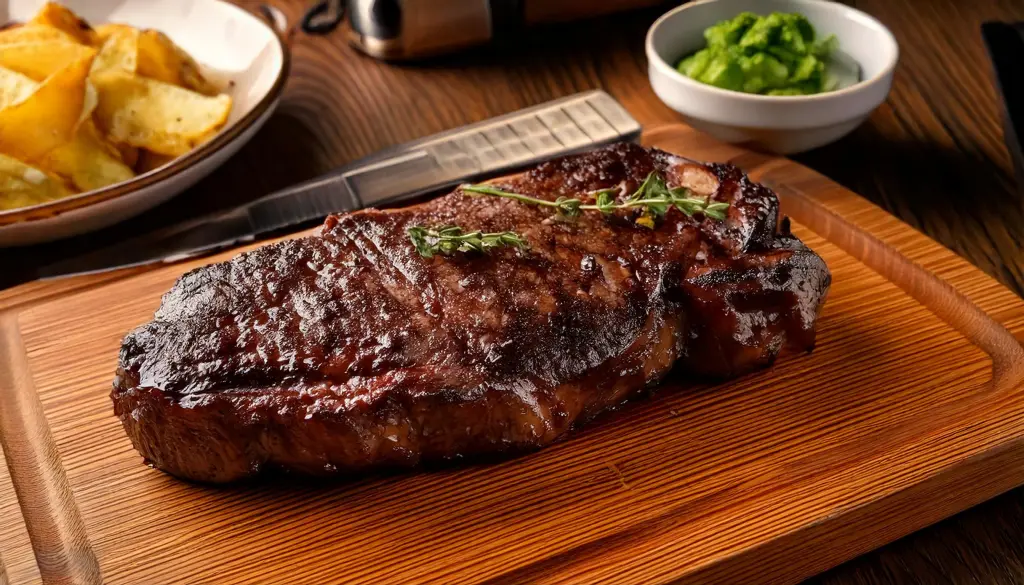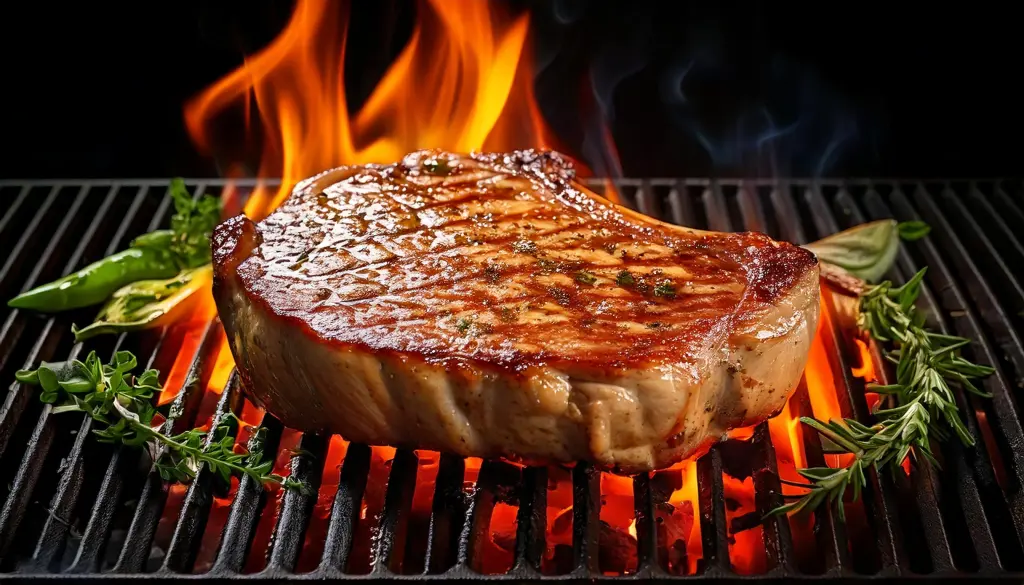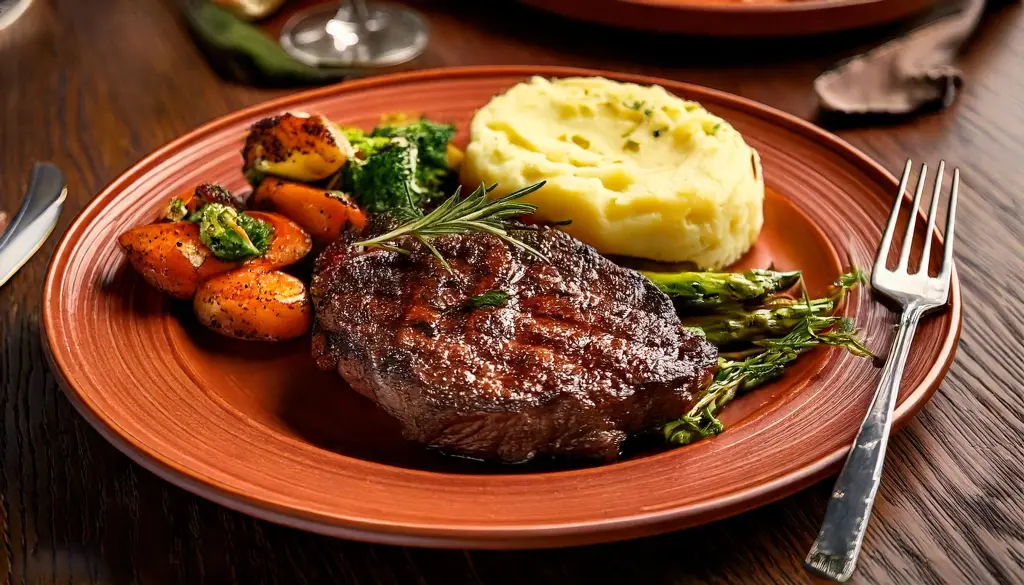Introduction
If you’re craving a steak that’s bold, flavorful, and larger-than-life, cowboy steak might be your next culinary obsession. This magnificent cut, often synonymous with indulgence and smoky grills, stands out for its rich marbling and bone-in presentation. Whether you’re a backyard barbecue enthusiast or a gourmet food lover, cowboy steak embodies the perfect balance of taste and tradition. In this article, we’ll explore everything you need to know about this iconic cut from its origins and preparation to the best ways to cook and enjoy it. Let’s dig in!
What Is a Cowboy Steak?
A cowboy steak is essentially a bone-in ribeye, celebrated for its thick cut and robust flavor. This cut is taken from the rib section of the cow, which is known for its tenderness and high fat content. The bone is usually frenched (cleaned), giving the steak a rugged yet refined appearance that’s perfect for presentation.
Why Is It Called a Cowboy Steak?
The name “cowboy steak” evokes images of hearty meals cooked over open flames on a ranch. While its exact origins remain a bit mysterious, the term likely stems from its association with cowboys of the Wild West who needed substantial, protein-packed meals to sustain their rugged lifestyles.
What Makes It Special?
The defining feature of this steak is its generous marbling, which enhances its juicy texture and flavor. When cooked properly, the fat melts into the meat, creating an unforgettable eating experience. Unlike a standard ribeye, the bone in a cowboy steak not only adds visual appeal but also contributes to its rich, meaty taste during cooking.
Characteristics of a Cowboy Steak
Key Features of a Cowboy Steak
What makes a cowboy steak so irresistible? Its distinctive features. This steak is often praised for its dramatic appearance and outstanding flavor profile, both of which make it a favorite among steak enthusiasts. Here’s what sets it apart:
- Bone-In Perfection: The attached rib bone is a hallmark of this cut, adding a rustic charm. The bone also acts as a natural insulator during cooking, helping to distribute heat evenly and retain juiciness.
- Marbling for Maximum Flavor: Known for its beautiful marbling, the cowboy steak is rich in intramuscular fat. This marbling melts into the meat when cooked, delivering an explosion of flavor and a tender texture.
- Impressive Thickness: This steak isn’t shy about its size. Typically cut to around 1.5 to 2 inches thick, it’s ideal for satisfying hearty appetites or impressing guests with its visual appeal.
How Does It Compare to Other Steaks?
The cowboy steak stands tall, both literally and figuratively, among its steak siblings. Let’s compare it to a few well-known cuts:
- Cowboy Steak vs. Tomahawk Steak: While both are ribeye cuts, the tomahawk steak is defined by its extra-long bone, giving it a more dramatic appearance. The cowboy steak has a shorter bone, making it easier to handle and cook.
- Cowboy Steak vs. Ribeye Steak: A ribeye is essentially the same cut, but without the bone. The presence of the bone in a cowboy steak enhances its presentation and flavor during cooking, giving it a slight edge for steak aficionados.
The Flavor Factor
Thanks to its marbling, the cowboy steak offers an incredibly rich flavor. When grilled or seared, the outer crust develops a savory char that contrasts beautifully with its juicy interior. Whether you prefer medium-rare or medium, this cut delivers a dining experience worth savoring.
Source and Preparation of Cowboy Steak

Where Does Cowboy Steak Come From?
The cowboy steak originates from the rib primal section of the cow, located near the back, along the spine. This area yields some of the most tender and flavorful cuts due to its lesser involvement in the animal’s movement. The rib primal section is also home to other premium cuts, like the ribeye and tomahawk steak, making it a prized area for steak lovers.
This cut typically comes from grain-fed or grass-fed cattle, with each type imparting unique flavor profiles:
- Grain-Fed Beef: Known for its buttery texture and slightly sweeter flavor, often resulting from the higher marbling content.
- Grass-Fed Beef: Offers a leaner cut with an earthier and more robust taste, ideal for health-conscious diners or those who prefer natural beef flavors.
How to Select the Perfect Cowboy Steak
Choosing the right cowboy steak is crucial for a memorable meal. Look for these qualities when shopping:
- Thickness: Opt for a steak that’s at least 1.5 inches thick to ensure even cooking and a juicy interior.
- Marbling: Seek out steaks with abundant white streaks of intramuscular fat for enhanced flavor and tenderness.
- Bone Presentation: Ensure the bone is cleanly frenched, giving the steak an appealing aesthetic and easy handling during preparation.
- Grade: High-quality grades, such as USDA Prime or Choice, often offer superior marbling and flavor.
How to Prepare Before Cooking
Proper preparation makes all the difference when it comes to a cowboy steak. Follow these steps for success:
- Bring to Room Temperature: Let the steak sit at room temperature for 30–45 minutes before cooking. This ensures even heat distribution and reduces the risk of overcooking the exterior.
- Season Generously: Use coarse salt, freshly ground black pepper, and garlic powder for a simple yet flavorful crust. Allow the seasoning to rest on the meat for at least 20 minutes before cooking to enhance flavor absorption.
- Pat Dry: Remove excess moisture with a paper towel before searing to achieve a beautifully browned crust.
- Oil the Steak, Not the Grill: Lightly coat the steak with a high-smoke-point oil like avocado or grapeseed oil for an even sear without sticking.
Best Cooking Methods for a Cowboy Steak
Top Cooking Methods
A cowboy steak can be cooked using various techniques, each bringing out its unique flavor and texture. Choosing the right method depends on your kitchen setup, equipment, and personal preference. Here are the most popular cooking methods:
1. Grilling

Grilling is the classic way to cook a cowboy steak. The open flame adds a smoky char that enhances its natural richness.
- Steps for Grilling:
• Preheat the grill to medium-high heat.
• Sear the steak for 2–3 minutes per side over direct heat.
• Move it to indirect heat and cook until the internal temperature reaches your desired doneness. - Pro Tip: Use a meat thermometer to monitor the internal temperature for perfect results.
2. Reverse Searing
The reverse sear method is ideal for thick cuts like the cowboy steak, ensuring a consistent cook with a gorgeous crust.
- How to Reverse Sear:
• Preheat the oven to 250°F (121°C).
• Place the steak on a wire rack over a baking sheet and cook until it’s 10–15°F below your target temperature.
• Finish by searing in a hot skillet with butter and aromatics like rosemary or garlic.
3. Pan-Searing
Pan-searing is perfect for a rich, caramelized crust, especially if you’re cooking indoors.
- Steps for Pan-Searing:
• Heat a cast-iron skillet over high heat until smoking hot.
• Add a tablespoon of oil and sear the steak for 2–3 minutes per side.
• Finish by basting the steak with melted butter, garlic, and herbs for added flavor.
4. Broiling
For an easy yet effective method, broiling in the oven offers consistent results without requiring a grill or stovetop.
- How to Broil:
• Preheat the oven’s broiler.
• Place the steak on a broiler pan about 4–6 inches from the heat source.
• Cook each side for 4–5 minutes, keeping a close eye to prevent overcooking.
Cooking Temperature Guide
Knowing your preferred doneness is key to a perfect steak. Use this temperature chart for reference:
- Rare: 120–125°F (49–52°C)
- Medium-Rare: 130–135°F (54–57°C)
- Medium: 140–145°F (60–63°C)
- Well-Done: 160°F+ (71°C+)
Tips for Serving and Pairing Cowboy Steak
How to Serve

The cowboy steak is a show-stopping cut of meat, and serving it properly can elevate the dining experience. Here’s how to ensure it shines on the plate:
1. Rest the Steak
After cooking, allow the steak to rest for at least 5–10 minutes. This step ensures the juices redistribute throughout the meat, giving you a tender, juicy bite every time.
2. Carve the Steak
Use a sharp knife to slice the steak against the grain. This technique breaks down muscle fibers, resulting in easier chewing and better flavor release. If serving family-style, cut thick slices and arrange them neatly on a platter for a rustic yet elegant presentation.
3. Enhance with Simple Garnishes
- Fresh Herbs: Add a sprig of rosemary or thyme for a fragrant touch.
- Compound Butter: Top with a dollop of garlic herb butter to enhance its richness.
- Flaky Salt: A sprinkle of finishing salt amplifies the flavors in each bite.
Perfect Pairings
Pairing the right sides and drinks can transform your cowboy steak meal into a culinary masterpiece.
Side Dishes That Shine
- Classic Mashed Potatoes: Creamy potatoes balance the steak’s bold flavor with their smooth texture.
- Grilled Vegetables: Charred asparagus, zucchini, or bell peppers add a smoky, earthy contrast.
- Creamed Spinach: This rich, velvety side is a timeless choice for steak dinners.
Sauces to Complement the Flavor
- Chimichurri: A zesty, herby sauce that cuts through the steak’s richness.
- Peppercorn Sauce: Adds a spicy, creamy element that complements the meat’s charred crust.
Cowboy Steak in History and Pop Culture
The Historical Origins
The cowboy steak harks back to the rugged days of the American West, when cattle ranchers and cowboys worked tirelessly herding livestock across vast plains. During the late 19th century, cowboys developed a love for hearty, bone-in steaks that could be easily cooked over an open flame.
The name “cowboy steak” is often linked to its primal, rustic appeal, reflecting the simplicity and practicality of cowboy meals. This cut became synonymous with strength and survival a fitting tribute to the grit of those who enjoyed it around campfires under star-filled skies.
Cowboy Steak in Modern Culture
In contemporary dining, the cowboy steak is celebrated as a premium cut, often featured in upscale steakhouses and food competitions. Its robust presentation and impressive size make it a centerpiece for special occasions.
Pop Culture Highlights
- Television Shows: The cowboy steak frequently appears in cooking competitions like MasterChef or Chopped, showcasing its versatility and the skill required to cook it to perfection.
- Steak Challenges: Many restaurants offer challenges, where patrons attempt to finish a massive steak within a time limit for a prize.
- Icon of the West: It remains a cultural symbol of the American cowboy, often featured in Western-themed movies or advertisements.
Common Mistakes to Avoid When Cooking
1. Skipping the Resting Period
One of the most common mistakes when preparing is cutting into it immediately after cooking. Resting the steak for 5–10 minutes allows the juices to redistribute, ensuring a moist and flavorful result.
Pro Tip: Cover the steak loosely with foil while it rests to retain warmth without steaming the crust.
2. Not Seasoning Properly
Failing to season the steak adequately is another misstep. A cowboy steak thrives on bold flavors, and insufficient seasoning can leave it tasting flat.
Best Practices:
- Use kosher salt and freshly cracked pepper generously before cooking.
- Let the steak sit with the seasoning for 30–40 minutes to allow the salt to penetrate the meat.
3. Overcooking or Undercooking
Due to its size and bone-in structure, it’s easy to overcook or undercook this cut. Incorrect cooking temperatures can result in a chewy or overly charred steak.
Avoid This by Following These Tips:
- Use a meat thermometer to monitor the internal temperature.
- Adjust your heat source (e.g., from direct to indirect heat) to cook evenly.
4. Not Preparing the Grill or Pan
Cooking a cowboy steak requires a hot, well-prepped surface to create the ideal crust and flavor. Starting on a cold or improperly heated grill or pan can lead to uneven cooking.
Fix It With These Steps:
- Preheat your grill or skillet for 5–10 minutes before placing the steak.
- Use high-quality oil with a high smoke point, like avocado oil, for pan-searing.
5. Ignoring the Bone
Many people forget the importance of the bone in a cowboy steak. Cooking it properly ensures even heat distribution, which enhances the overall flavor and tenderness.
Pro Tip: Cook the steak bone-side down first to heat the bone, helping the meat near it cook evenly.
With these common pitfalls addressed, you’ll be fully prepared to enjoy the perfect cowboy steak. Whether grilling, pan-searing, or broiling, the right approach ensures an unforgettable dining experience.
FAQs About Cowboy Steak
1. What is a cowboy steak?
A cowboy steak is a bone-in ribeye, often cut with a larger rib bone that makes it visually striking. The steak is known for its rich marbling, tender texture, and bold beef flavor. It’s a popular cut among steak lovers who appreciate a juicy, well-cooked piece of meat, often prepared on the grill or in the oven.
2. How do I cook a cowboy steak?
To cook a cowboy steak, you can either grill it or pan-sear it before finishing it in the oven. The key is to use high heat to sear both sides, creating a crust, then cook the steak to your preferred doneness using indirect heat or in the oven. Be sure to rest the steak after cooking to ensure the juices stay within the meat.
3. How do I know when my cowboy steak is done?
The best way to check for doneness is by using a meat thermometer. For a cowboy steak, the following temperatures are recommended:
- Rare: 120°F–125°F
- Medium-rare: 130°F–135°F
- Medium: 140°F–145°F
- Medium-well: 150°F–155°F
- Well-done: 160°F+
Be sure to allow the steak to rest for 5–10 minutes before slicing to maintain its juiciness.
4. What should I serve with a cowboy steak?
Cowboy steak pairs wonderfully with classic sides like mashed potatoes, grilled vegetables, and creamed spinach. You can also opt for sauces like peppercorn or chimichurri to complement the steak’s rich flavor. For an elevated experience, finish the steak with a dollop of garlic herb butter.
5. Can I cook a cowboy steak on a cast iron skillet?
Yes, a cast iron skillet is perfect for cooking a cowboy steak. It retains and distributes heat evenly, giving you the perfect sear on the outside while keeping the inside juicy. You can finish it in the oven if necessary for the right doneness.
6. Is a cowboy steak the same as a Tomahawk steak?
While both are bone-in cuts, a Tomahawk steak is a larger version of the cowboy steak. The key difference is that the Tomahawk has a longer bone (typically 6–8 inches), while the cowboy steak has a shorter bone. Both cuts offer the same flavor profile due to their ribeye nature.
Conclusion
The cowboy steak is much more than just a cut of beef; it’s a culinary experience that brings bold flavors and rich history to the table. Whether you’re grilling it on a summer evening or serving it for a special occasion, this steak is sure to impress. By following the tips and techniques mentioned in this guide, you’ll have everything you need to prepare a perfectly cooked cowboy steak. Don’t forget to rest it, season it well, and pair it with your favorite sides and sauces to make the most of this magnificent cut. Happy cooking!
